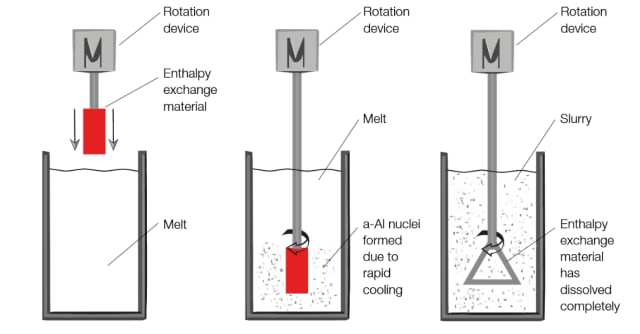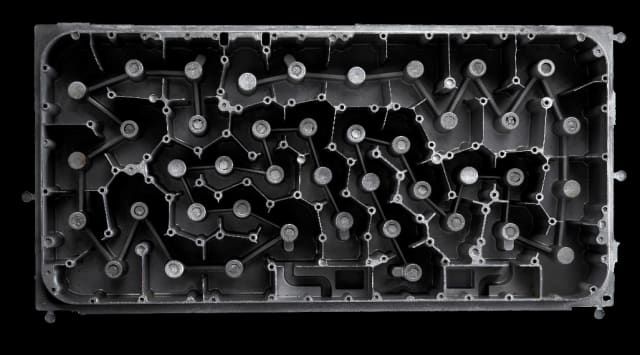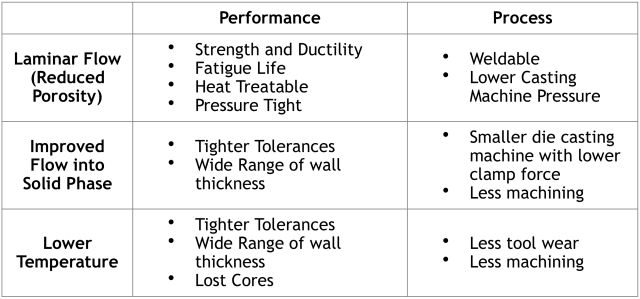The drive to reduce material use and improve performance is resulting in products with more complex and organic shapes. At the same time, the pandemic has highlighted the fragility of global supply chains, accelerating the reshoring of manufacturing. Not only does this improve resilience; it also reduces supply chain emissions and enables a more timely response to changing demand.
Additive manufacturing is sometimes portrayed as a universal solution that can produce parts on-site without any limitations on product form or variety. The reality is, of course, that additive manufacturing remains a relatively slow process that inevitably means a compromising choice between high cost or low performance.
Die casting is often a more cost-effective way to produce complex components in significant volumes. Although die casting can accurately produce complex components in high-performance alloys with fine grain structures, it has some limitations. Most notably, it is very difficult to achieve low porosity, due to the turbulent flow entering the mold. The very small air bubbles that inevitably become trapped in the molten metal reduce strength in two ways. Firstly, the voids act as crack initiation sites that can result in brittle failure and reduced fatigue life. Secondly, the presence of small air bubbles may mean that the casting cannot be heat treated. For aluminum alloys, this has a very significant impact on performance.
Semi-solid casting can eliminate porosity by allowing a more laminar flow into the mold, and therefore it can achieve performance closer to a forged part. A lower temperature and improved pressure distribution can also result in lower process costs. Semi-solid casting can also enable the casting of alloys not possible with high-pressure die casting, such as very low silicon giving high thermal conductivity and alloys with high elongation for car chassis.
How Semi-Solid Casting Differs from Die Casting
In both semi-solid casting and die casting, metal is forced into a mold, known as a die, at high temperature and pressure. Each shot may include more than one casting, as well as the sprue, runners and gates, as detailed in my recent article on die casting. The key difference between die casting and semi-solid casting is that in die casting the metal is in a fully liquid state, while in semi-solid casting the metal is between its solidus and liquidus temperatures. This means that there is a mixture of solid globules surrounded by liquid metal. In this state, the semi-solid metal exhibits thixotropy. This is a property where a fluid is relatively viscous when static but becomes less viscous when subjected to shear stress. Thixotropy is time-dependent shear thinning, meaning that after stress is removed, the fluid’s viscosity does not return immediately but takes a period of time. The faster you shear the melt, the less force you need to apply. Thixotroic melts and slurries are common in nature as peanut butter, paint and toothpaste. In semi-solid alloys, the formation of crystals is also beneficial to the process. The dendritic structure in die casting causes the melt to clog, while a semi-solid melt has spherical alfa grains that are free to move, resulting in a more even pressure distribution. These properties allow the mold to continue being filled until a 75 percent solid fraction is reached, reducing shrinkage and therefore improving tolerances. They also allow more complex shapes to be cast. Another important characteristic of the semi-solid flow into the mold is that it generally remains laminar. This laminar flow doesn’t trap air bubbles and it also requires lower pressures.
Semi-Solid Casting Processes
There are three distinct semi-solid casting processes:
- Thixocasting is an older process typically used for aluminum alloys. It requires a specially precast billet with a nondendritic microstructure, adding significant costs to the process. This billet is then induction heated to form a semi-solid within a conventional die casting machine, before being injected into a die. This process makes it very difficult to reuse material as it must first be recast into a billet with the correct microstructure.
- Rheocasting is a newer process used for aluminum alloys. It uses the same casting machine, furnace and handling automation as conventional die casting. The only difference is the addition of a slurry maker, which is simply a spindle that stirs the metal in a crucible as it is being transferred from the furnace to the casting machine. The solid fraction is high, which is important for a good result.
- Thixomolding is used for magnesium alloys. It is very similar to injection molding of plastics with magnesium alloy chips fed into a barrel where they are heated and pressurized using a screw conveyor. The action of the screw generates shear forces required for thixotropic thinning.

Strain-induced melt-activated (SIMA) is a method of preparing aluminum alloys for thixocasting using hot and cold working.
Advantages of Semi-Solid Casting
There are many advantages to semi-solid casting when compared to conventional die casting. These may be broadly divided into process and performance benefits. They result from lower temperatures, lower pressures, and laminar flow into the mold.
The laminar flow of material into the die means that far less air is trapped and porosity is very low. This brings several performance benefits. Firstly, the absence of significant voids, which could act as crack initiation sites, directly improves strength and ductility of a material. It reduces the likelihood of a sudden brittle failure and extends the fatigue life. A secondary strength-enhancing effect is that when porosity is low it becomes possible to apply the treatment period. SAG state that they are able to produce aluminum alloys with a T6 heat treatment that achieves 270 MPa yield stress and 330 MPa ultimate stress. Lower porosity also means that components can be welded and that they are suitable for pressure tight applications.
The lower temperature, in combination with the high proportion of solid in the melt (which has already shrunk), means that less shrinkage occurs. This enables tighter tolerances to be maintained. Wall thicknesses can vary between less than 1 mm and over 20 mm. More rapid transitions between wall thickness may also be possible, although limitations remain. For example, when opening out to a large thickness after passing a small thickness, “freezing off” may lead to shrinkage porosities. It is also possible to include lost cores to cast features that would not normally allow extraction.

In terms of manufacturing process, the lower temperature of the metal when it enters the die means less tool wear and therefore lower long-term manufacturing cost. Improved tolerances mean that more features can be included in the casting, reducing the requirement for post-process machining.

Semi-solid casting can be an affordable process. Rheocasting is often cheaper than conventional high-pressure die casting due to there not being a requirement for additives, much smaller casting machines needed, and the reduced tool wear. At the same time, it can produce very high-quality castings, with thin sections that are not possible using conventional die casting. The lower pressures can also make larger components feasible since the casting machine can be smaller. This is increasingly becoming a key manufacturing process.
Source: engineering










